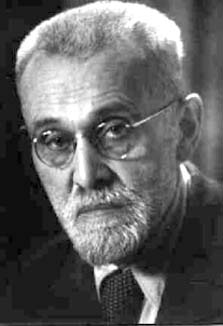


 تاريخ الرياضيات
تاريخ الرياضيات
 الرياضيات في الحضارات المختلفة
الرياضيات في الحضارات المختلفة 
 الرياضيات المتقطعة
الرياضيات المتقطعة
 الجبر
الجبر
 الهندسة
الهندسة 
 المعادلات التفاضلية و التكاملية
المعادلات التفاضلية و التكاملية 
 التحليل
التحليل
 علماء الرياضيات
علماء الرياضيات |
Read More
Date: 26-4-2017
Date: 1-5-2017
Date: 26-4-2017
|
Died: 1953 in Halle, Germany

Heinrich Jung's father was Wilhelm Jung. Heinrich studied mathematics, physics and chemistry at the University of Marburg and at the University of Berlin from 1895 to 1899. His teachers included the following mathematicians: Friedrich Schottky who had moved to Marburg from Zurich in 1892; Kurt Hensel who taught Jung at Berlin but later moved to Marburg; Lazarus Fuchs who had moved to Berlin from Heidelberg in 1884; Georg Frobenius who moved from Zurich to Berlin in 1892; and Hermann A Schwarz who moved from Göttingen to Berlin in 1892. Jung was also taught in Berlin by the theoretical physicist Max Planck who moved from Kiel to Berlin in 1888. Mathematics was Jung's main interest and, from this star-studded collection of teachers, it was Hensel in Berlin and Schottky in Marburg who were the greatest influence on him. It was Schottky who became Jung's doctoral thesis advisor, and he was awarded his doctorate in 1899 from for his thesis Über die kleinste Kugel, die eine räumliche Figur einschliesst which was published in Crelle's journal.
As well as being awarded his doctorate in 1899, Jung passed the state examinations to allow him to teach in a gymnasium in the same year. In 1902 he submitted his habilitation thesis Die Wurzelfunktionen in dem durch die Gleichung G(p, q) = 0 vom Range 2 und durch die Gleichung z = H(p, q) definierten algebraischen Körper K(p, q) to Marburg and he then became a privatdozent there. Jung remained at Marburg until 1908 when he was appointed as a professor in Kiel. From 1913 he taught as a secondary school teacher in Hamburg. Soon after this World War I broke out and Jung spent a short time undertaking war work. After the war ended he received an appointment at the University of Dorpat in 1918. Two years later he succeeded Wangerin at the University of Halle, where he continued to teach until he retired in 1948. After he retired he taught for a further three years.
Most of Jung's work involved looking at algebraic functions. Among his publications we give a few examples of those which were early in his career: Über die Transformation algebraischer Körper vom Range 1 (1904), Ein Satz über Thetafunktionen (1905), Darstellung der Funktionen eines algebraischen Körpers zweier unabhängiger Veränderlicher x, y in der Umgebung einer Stelle x = a, y = b (1908), Primteiler algebraischer Funktionen zweier unabhängiger Veränderlichen und ihr Verhalten bei birationalen Transformationen (1908). Jung published some important books: Einführung in die Theorie der algebraischen Funktionen einer Veränderlichen (de Gruyter, Berlin and Leipzig, 1923), Algebraische Flächen (Helwingsche Verlagsbuchhandlung, Hannover, 1925), Einführung in die Zahlentheorie (Jänicke, Leipzig, 1935), Einführung in die Theorie der quadratischen Zahlkörper (Jänicke, Leipzig, 1936), Matrizen und Determinanten (Jänicke, Leipzig, 1948), and his final publication, which incorporated much that had appeared in his research papers over the years, Einführung in die Theorie der algebraischen Funktionen zweier Veränderlicher (Akademie-Verlag, Berlin, 1951). It will help to give a flavour of Jung's work if we look more closely at his final book. Here are some extracts from a review by Chevalley of the book:-
Let K be a field of algebraic functions of two variables over the field of complex numbers. The geometric approach to the study of K is by means of the points of some algebraic surface, preferably free from singularities, which is a model of the field K. The analytic approach, followed in the present book, uses as fundamental concept that of a place of the field K, a place being an isomorphism of K into the quotient field of the ring of convergent power series in two variables (the uniformizing variables at the place) with the requirement that distinct couples of values of the variables u, v in these power series sufficiently near to (0, 0) should lead to distinct values for some function of the field. ...
We now turn to a brief description of the contents of the book. The introduction is concerned with the study of the field of rational functions of two variables. It contains an exposition of the method of reduction of singularities of a plane curve by quadratic transformations. Part I introduces the main concepts (places and divisors) ... Part II is concerned with proof of the Riemann-Roch theorem. ... Part III is concerned with the "place transformations", i.e. the simultaneous consideration of several systems of places for the same field. ... Part IV is concerned with the theory of differentials, which is developed in the Picard style. ... Part V is concerned with the theory of algebraic equivalence of divisors and of the Picard variety. ... Part VI is concerned with the theory of punctual divisors and their equivalence. ... The last and seventh part is concerned with more special problems: a new expression for the Zeuthen-Segre invariant, a detailed study of fields of the form C(x,y,(W(x, y))1/2, and the study of surfaces with a pencil of rational curves, leading to Enriques' theorem.
On the whole, the book contains a very large mass of information about algebraic surfaces over the field of complex numbers.
Articles:



|
|
|
|
"إنقاص الوزن".. مشروب تقليدي قد يتفوق على حقن "أوزيمبيك"
|
|
|
|
|
|
|
الصين تحقق اختراقا بطائرة مسيرة مزودة بالذكاء الاصطناعي
|
|
|
|
|
|
|
مكتب السيد السيستاني يعزي أهالي الأحساء بوفاة العلامة الشيخ جواد الدندن
|
|
|